
Chicagoland MG Club

Back to Archives
Submit an article
Cover
Intro & Club Officers
Left Hand Drive
Right Hand Drive
Meeting Report, Sept.
New Members
CMGC Project Car!
Wine, Cheese, Beer Tour
Natter 'n' Noggin
30 Years of Newsletters
Fall Color Tour
Return to Abingdon 2006
Just For Amy
Should SU’s get Rebuilt?
CMGC Events
Other Events
Classifieds
Newest in “MG” Fashion
Regalia Items Available
Regalia Order
Back Cover
|
|

Should your S.U.’s get Rebuilt?
 I got my latest issue of Classic Motorsports and read the article that was “all about SUs.” I had to go back and look through the article a second time because I thought it would be all about SUs and there was something glaringly missing … any mention of how to check the air chamber and piston for wear. I got my latest issue of Classic Motorsports and read the article that was “all about SUs.” I had to go back and look through the article a second time because I thought it would be all about SUs and there was something glaringly missing … any mention of how to check the air chamber and piston for wear.
 As you have surely read or heard many times before, SU carbs can be rebuilt many times and to varying degrees. There are relatively few moving parts in these, especially in the H and HS series carbs: the throttle shafts are the moving part that gets the most attention. If they are worn, they can be replaced. If the bushes they ride in are worn, they can be reamed .010” oversize and the carb fitted with an oversize shaft, or the bush can be replaced with the original size and a new standard size shaft fitted. Even if the bushes can’t be reamed to .010” over you can still install new bushes and ream to fit for standard size shafts. Any of these approaches, if done correctly, results in good as new performance. New jets and needles, float needle and seats, linkage parts, gaskets, it can all be had and when selected and installed correctly will result in your carb functioning just as it is supposed to. As you have surely read or heard many times before, SU carbs can be rebuilt many times and to varying degrees. There are relatively few moving parts in these, especially in the H and HS series carbs: the throttle shafts are the moving part that gets the most attention. If they are worn, they can be replaced. If the bushes they ride in are worn, they can be reamed .010” oversize and the carb fitted with an oversize shaft, or the bush can be replaced with the original size and a new standard size shaft fitted. Even if the bushes can’t be reamed to .010” over you can still install new bushes and ream to fit for standard size shafts. Any of these approaches, if done correctly, results in good as new performance. New jets and needles, float needle and seats, linkage parts, gaskets, it can all be had and when selected and installed correctly will result in your carb functioning just as it is supposed to.
 There’s just one component of the carbs that generally gets ignored though, and they’re the part that jumps out at you first. The air chamber and piston assemblies are the one part that can not be rebuilt, but are most often ignored even though their condition greatly affects your carburetors performance. If they are worn out, the carbs will not run correctly. Why? They are the reason SUs are known as constant depression (depression=vacuum) carburetors. Intake manifold vacuum determines how the piston rises and therefore where the needle is in relation to the jet, and therefore how much gas is going into the mixture. There’s just one component of the carbs that generally gets ignored though, and they’re the part that jumps out at you first. The air chamber and piston assemblies are the one part that can not be rebuilt, but are most often ignored even though their condition greatly affects your carburetors performance. If they are worn out, the carbs will not run correctly. Why? They are the reason SUs are known as constant depression (depression=vacuum) carburetors. Intake manifold vacuum determines how the piston rises and therefore where the needle is in relation to the jet, and therefore how much gas is going into the mixture.
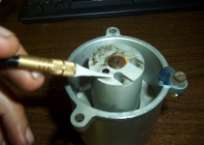 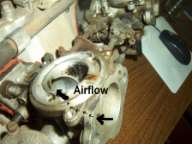
You know how the piston has two ¼” or so holes on the bottom on the side closest to the cylinder head? Those lead to the open area above the piston and inside the air chamber. There is another pair of holes on the outside face of the carb that mates to the air cleaner. These also lead inside the air chamber, but to the underside of the piston.
This is just a brief explanation, but when your foot opens the butterfly, manifold vacuum seeks to draw air into the engine. This rush of air going into the intake causes the air to be drawn out of the chamber within the air chamber by way of the orifices in the piston. With that partial vacuum that has just been created, there is a pressure differential between the chamber inside and above the piston and the space inside the air chamber and below the piston; low pressure above, high(er) pressure below. The pressure differential causes the piston to rise, thus letting more fuel into the mix due to the needle being pulled up. Now imagine if the fit between the piston and inner air chamber surface was too loose. The pressure differential would be influenced not only by the difference between the manifold/carb throat and the atmosphere outside the carb/air cleaner area but also by the “leakage” between the two spaces within the air chamber. This would effectively reduce the pressure differential between the two areas, therefore reducing the need for the piston to rise within the air chamber to make up for the pressure differential. So what happens is you step on the gas, more air is going into the engine, but more gas is not because the needle is not rising.
 Sounds like this air chamber and piston component is fairly important to carb performance, huh? They need to do more than just slide freely up and down, as so many ads and eBay listings say. To know how well they work, you need to test them, and here’s how. This test is known as the piston drop test. Sounds like this air chamber and piston component is fairly important to carb performance, huh? They need to do more than just slide freely up and down, as so many ads and eBay listings say. To know how well they work, you need to test them, and here’s how. This test is known as the piston drop test.
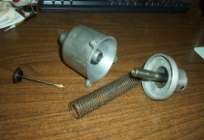
 1) Remove the air chamber from the carb
2) unscrew and remove the damper
3) dump the oil out of the dashpot
4) remove the piston and take out the piston return spring
5) clean up the chamber and piston
6) there shouldn’t be anything left now except the piston and the empty air chamber – it doesn’t matter if the needle is still in the piston
7) stop up the two holes in the piston so they are airtight
8) hold the air chamber upside down with the piston all the way in and hold it so you can let the chamber go while still hanging on to the piston
9) using a stopwatch, check how long it takes for the air chamber to travel from the starting position to the point where the edge of the piston is even with the bottom edge of the dashpot. The factory book suggests using the carb part # tag to make a stop for the piston.
1) Remove the air chamber from the carb
2) unscrew and remove the damper
3) dump the oil out of the dashpot
4) remove the piston and take out the piston return spring
5) clean up the chamber and piston
6) there shouldn’t be anything left now except the piston and the empty air chamber – it doesn’t matter if the needle is still in the piston
7) stop up the two holes in the piston so they are airtight
8) hold the air chamber upside down with the piston all the way in and hold it so you can let the chamber go while still hanging on to the piston
9) using a stopwatch, check how long it takes for the air chamber to travel from the starting position to the point where the edge of the piston is even with the bottom edge of the dashpot. The factory book suggests using the carb part # tag to make a stop for the piston.
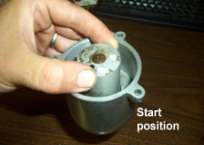 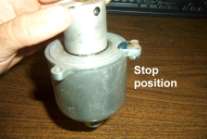
 I recommend doing the test several times to be sure you have the hang of it and to be sure you get an accurate time. I recommend doing the test several times to be sure you have the hang of it and to be sure you get an accurate time.
 The factory specs for the drop times are as follows: for HS-2 – 3 to 5 seconds, HS-4 and HIF-4 – 4 to 6 seconds, and HS-6, HIF-6 and HIF-44 - 5 to 7 seconds. If it takes less time, that indicates wear. Besides just wear, you also want to look for similarity of times. If the carbs give different results in the test, that indicates they will perform differently when on the car. That makes balancing them pretty darn tough. The factory specs for the drop times are as follows: for HS-2 – 3 to 5 seconds, HS-4 and HIF-4 – 4 to 6 seconds, and HS-6, HIF-6 and HIF-44 - 5 to 7 seconds. If it takes less time, that indicates wear. Besides just wear, you also want to look for similarity of times. If the carbs give different results in the test, that indicates they will perform differently when on the car. That makes balancing them pretty darn tough.
 If the air chambers and pistons are not going to perform well enough, then it will make other efforts a bit of a waste. New assemblies are available, but are pretty pricey. Fortunately, good secondhand assemblies are still around at a reasonable price. There’s also the option of buying all new carbs. - Safety Fast, Wade Keene If the air chambers and pistons are not going to perform well enough, then it will make other efforts a bit of a waste. New assemblies are available, but are pretty pricey. Fortunately, good secondhand assemblies are still around at a reasonable price. There’s also the option of buying all new carbs. - Safety Fast, Wade Keene
|
|






